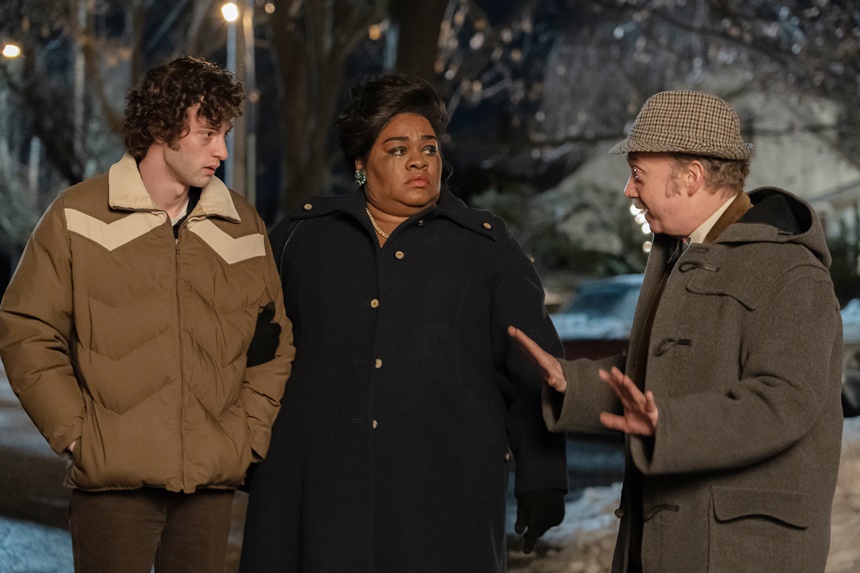The Holdovers
⭐️ ⭐️ ⭐️ ⭐️
Rating: R
Run Time: 2 hours 13 minutes
Writer: David Hemingson
Director: Alexander Payne
Reviewed at the Toronto International Film Festival
Unabashedly sentimental, defiantly humane, wickedly funny, The Holdovers is a lot like the holidays: a gamut of emotions wrapped up in regrets of the past and uncertainty about the future — tempered by that seasonal dash of against-all-odds optimism.
It also marks a triumphant return for director Alexander Payne, accomplishing his most satisfying work since Nebraska, an impossible 10 years ago.
Paul Giamatti — reunited with Payne 14 years after they turned the world against Merlot in Sideways — plays Paul Hunham, a solitary, universally disliked ancient history teacher at a posh New England boys’ school during the Vietnam War era. The kids — and some of his colleagues — secretly call him Walleye because, well, because of his walleye: an undisciplined left eye that wanders distressingly, leaving the impression that Paul at once sees everything and also nothing.
Newcomer Dominic Sessa is Angus Tully, a solitary, equally unliked junior at said school. We meet the pair in a wood-paneled classroom where, on the last day before Christmas vacation, Paul is gleefully distributing failing essays to the moaning class.
One by one, the kids — virtually all of them seemingly spoiled beyond redemption — depart with the parents they haven’t seen since Labor Day. Angus is standing at the door with his suitcase — only to get a phone call from his mother informing him, in an apologetic yet heartless tone, that he’ll have to stay at school so she can jet off on vacation with her new hubby.
And so Angus slinks back inside, the worst day of his life made even more unbearable with the news that his caretaker for the next two weeks will be none other than Paul — who has been assigned babysitter duty as punishment for giving a bad grade to an influential politician’s son.
At the outset, Angus and Paul are a pair of scorpions in a holiday-wrapped shoebox, circling each other cautiously, landing occasional jabs with their poison dart stingers. Their toxic relationship is mitigated only by the presence of Mary (Da’Vine Joy Randolph), the school cook, whose no-nonsense attitude masks heartbreak over the recent death of her son in Vietnam.
Payne, who has a knack for casting just the right actors for his films, has also long been a director who coaxes indelible performances from them. He clearly relishes working with Giamatti again, fashioning a character who has struck an uneasy truce with rejection and loneliness. Sessa’s Angus is a seething adolescent broth of anger, hurt, and hubris — a kid who we can imagine, five decades hence, ending up a lot like his maladjusted teacher, alone in his apartment, smoking a pipe and reading murder mysteries.
If there’s anyone with whom both Paul and Angus can find a connection, it’s Mary, who spends the two weeks scratching out meals from whatever has been left lying around the kitchen. She, too, is stuck at the school — and also stalled in an abyss of sadness over the loss of her son, who just a year earlier was walking these halls as a scholarship student. Unable to afford college, he lost his deferment and was sent to his death in the rice paddies of Southeast Asia. As Mary, Randolph personifies a strong woman pushed to her limits, losing herself in her work by day, then sitting sleepless on a couch, chain smoking in the flickering light of late-night TV. The Holdovers is a film of quiet pleasures, and perhaps the most pleasingly quiet ones come when Paul drops in on Mary, not necessarily to talk; mostly to simply sit next to her on that couch, stare at the TV and feel a little less lonely. It’s hard to imagine two characters who are less similar, yet such perfect company.
The Holdovers is set in 1970, and Payne has crafted a film that looks and feels as if it were made that year and sealed in a time capsule. Even the opening production logos for Focus Features and Miramax — two outfits that did not exist at the time — are rendered in the stark, stridently colorful graphic style of the time.
Accordingly, Payne adopts the leisurely style of that era’s films — the lingering shots of Ryan’s Daughter, the near-cloying sentiment of Love Story, the quirky characters of The Owl and the Pussycat — unapologetically old-fashioned; a less traumatized Dead Poets Society.
The narrative shambles a bit over its 2 hours and 13 minutes, occasionally defying the rules of cinematic storytelling. But people rarely reveal themselves in neat three-act dramas, and the characters here are in no hurry, telling us what they want us to know about themselves in their own good time.
Become a Saturday Evening Post member and enjoy unlimited access. Subscribe now



